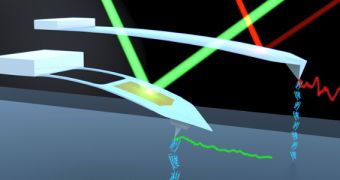In a paper published in the March 26 online issue of the top scientific journal ACS Nano, researchers at JILA (a research organization formerly known as the Joint Institute for Laboratory Astrophysics) describe a new probe destined for use inside atomic force microscopes (AFM). This device is much shorter and significantly more flexible than other designs, which translates into a higher accuracy level.
JILA physicists say that their instrument will make nanotechnology studies much easier, especially where the smallest obtainable structures are concerned. In the field of medicine and molecular biology, the new probes will allow AFM to conduct state-of-the-art precision and stability measurements of DNA, proteins, enzymes and other biomolecules.
A more flexible probe translates into more precise measurements of picoscale forces, such as those that develop inside and between very small structures. It is important to note here that AFM instruments are so sensitive that they can measure and image single atoms. With the addition of the softer, more agile tips, these tools will be able to increase their sensitivity several times over, experts comment.
The most important component of an AFM is its probe, which is a device resembling a cantilever, or an unbelievably small diving board stretching out into a liquid that contains the molecules that scientists want to study. The cantilever ends in a minuscule tip, which attaches to a molecule, and then pulls on it.
The internal computers in the AFM detect the minute deformations that occur in the probe as it pulls on the molecules, and are able to derive precious data on the nature of those targets based on these readings. The deflections that occur in the cantilever are on the order of trillionths of a newton (piconewtons). By comparison, one newton is about equal to the weight of a small apple.
The new study represents the third breakthrough advancement that the JILA team has put under its belt in AFM technology over the past few years. The research was sponsored by the US National Science Foundation (NSF) and the US National Institute of Standards and Technology (NIST). The latter operates JILA under a partnership agreement with the University of Colorado in Boulder (UCB).
“Amazingly, this project was spearheaded by a talented undergraduate. We hope other groups with similarly talented students will adopt these cantilevers. We certainly are,” explains Tom Perkins, who is a biophysicist at both NIST and JILA.
“Previously, we had to average the Brownian (random) motion of our favorite cantilever for about 60 milliseconds to get a measurement that had a precision of 1 piconewton. Now, we can get the same precision in 1 millisecond or so,” the expert says of his team's latest advancement in AFM technology.

 14 DAY TRIAL //
14 DAY TRIAL //